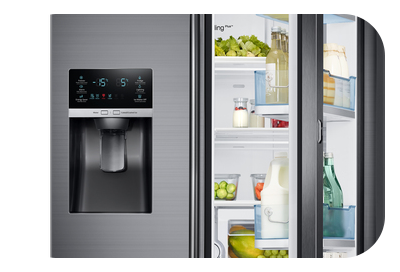Tips for an organized Samsung refrigerator
We know that your fridge plays a critical role in your family's diet. And the larger your family, the more food you will need. You probably don't think about it that much, but where you place food in the fridge can really affect how long the food lasts. Use these tips to organize your fridge and keep your food fresh.

Many people like to place items in the fridge door for quick and easy access. But this may not be the best thing for certain types of food.
This is because the refrigerator's door is the warmest part of the fridge. When you open the door, these items are exposed to the warm outside air, which heats them up.
So you should only put items that don’t need to be very cold in the fridge's door bins, such as :
- Condiments , cooking oil
- Butter , water
- Juice,soda
The upper shelves are the second warmest part of the fridge.This area can reach up to 40°F, which is the ideal temperature for many foods.
This makes it a good place to keep items that need to be cool but not overly cold.
Storing certain items on the top shelf can prevent this while also keeping your food nice and cold.
Here are examples of food to store on the upper shelves:
Jam and jelly, peanut butter
Cheese, yogurt
Leaftovers, snacks
The lower shelves are the coldest part of the fridge.
This makes it a great place to store items that spoil easily or are more likely to develop bacteria. The cold air naturally helps to preserve the food, so the bacteria won't grow as quickly.
Always store these items near the bottom of the fridge to prevent them from going funky:
- Milk
- Eggs
- Raw fish, meat,and poultry
Fruits and veggies have their very own special place in the fridge called crisper drawers. These drawers let you adjust the humidity depending on what kind of items you're storing.
Vegetables like when the humidity is set to high, whereas fruits like it set to low. Usually, there are two crisper drawers available to help separate your produce.
But if you're still a little unsure of what goes where, here's a helpful list:
Low-humidity drawer
- Mushrooms, peppers, summer squash, apples
- Ripe pears, ripe avocados, peaches and melon
High-humidity drwawer
- Herbs, cabbage, broccoli
- Green onions, leafy greens
You're probably inclined to put everything in the fridge to help it last longer. However, your fridge can actually affect foods in different ways. For example, honey will crystallize in the fridge and bananas will take longer to ripen.
Here are some items you should not place in the fridge:
- Bananas, bread, coffee, and olive oil
- Onions, potatoes, honey, and berries
Here are some other tips to help organize your fridge and get the most out of your food:
To prolong the freshness of eggs, store them in their original carton.
Prevent meat drippings from contaminating other foods by placing them on trays or in sealed bags.
Extend the shelf life of bread by freezing it for a few weeks.
Enhance fridge organization with a small lazy susan for easy container access.
Cool large leftovers quickly by using multiple small containers and placing them at the front of the fridge for easy retrieval.
Keep odorous foods in airtight containers to prevent their smells from spreading.
Store leftovers at eye level to ensure you remember to consume them before they spoil.
Having an organized freezer is just as important, if not more important, than an organized fridge because the freezer is meant to help food last as long as possible. Follow these tips for a tidy ice box that can fit more food:
Avoid storing highly perishable items on the freezer door due to frequent exposure to warm air. Instead, use this space for items like bread, ice packs, butter, flour, or nuts.
Utilize the top shelf for non-leaky items such as bread, baked goods, fruits, and vegetables, as well as popsicles and ice cream.
Store potentially leaky items like meat, fish, soups, sauces, and prepared meals on the bottom shelf to prevent contamination.
Note: For further assistance or questions, please Contact us.
Thank you for your feedback!
Please answer all questions.